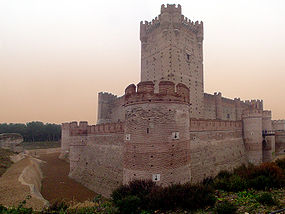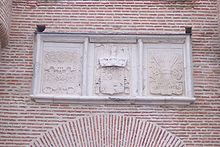
Castle of La Mota
Encyclopedia

Medina del Campo
Medina del Campo is a town located in the middle of the Spanish Meseta Central, in the province of Valladolid, Castile-Leon autonomous region, 45 km from Valladolid. It is the capital of a farming area, far away from the great economic centres.-History:...
, province of Valladolid, Spain
Spain
Spain , officially the Kingdom of Spain languages]] under the European Charter for Regional or Minority Languages. In each of these, Spain's official name is as follows:;;;;;;), is a country and member state of the European Union located in southwestern Europe on the Iberian Peninsula...
. It is so named because of its location on an elevated hill, a mota, from where it dominates the town and surrounding land. The adjacent town came to be surrounded by an expanding series of walls in subsequent years, of which little remains.
It has been protected by the state since 1904, first as a national monument and more recently as a site of cultural interest, or Bien de Interés Cultural
Bien de Interés Cultural
A Bien de Interés Cultural is a category of the Spanish heritage register. This category dates from 1985 when it replaced the former heritage category of Monumento nacional in order to extend protection to a wider range of cultural property...
. The castle itself was reconstructed in the twentieth century. Reconstruction was mainly pursued by the Falange
Falange
The Spanish Phalanx of the Assemblies of the National Syndicalist Offensive , known simply as the Falange, is the name assigned to several political movements and parties dating from the 1930s, most particularly the original fascist movement in Spain. The word means phalanx formation in Spanish....
government of Francisco Franco
Francisco Franco
Francisco Franco y Bahamonde was a Spanish general, dictator and head of state of Spain from October 1936 , and de facto regent of the nominally restored Kingdom of Spain from 1947 until his death in November, 1975...
, who had a nostalgia for structures having links to the Catholic Monarchs
Catholic Monarchs
The Catholic Monarchs is the collective title used in history for Queen Isabella I of Castile and King Ferdinand II of Aragon. They were both from the House of Trastámara and were second cousins, being both descended from John I of Castile; they were given a papal dispensation to deal with...
.
Overview
The castle's main feature is the large outer barbicanBarbican
A barbican, from medieval Latin barbecana, signifying the "outer fortification of a city or castle," with cognates in the Romance languages A barbican, from medieval Latin barbecana, signifying the "outer fortification of a city or castle," with cognates in the Romance languages A barbican, from...
. The interior castle has a trapezoidal plan, with 4 towers and a square yard
Yard (land)
A yard is an enclosed area of land, usually tied to a building. The word comes from the same linguistic root as the word garden and has many of the same meanings....
. It has a large square keep
Keep
A keep is a type of fortified tower built within castles during the Middle Ages by European nobility. Scholars have debated the scope of the word keep, but usually consider it to refer to large towers in castles that were fortified residences, used as a refuge of last resort should the rest of the...
tower, and an inner curtain wall
Curtain wall
A curtain wall is an outer covering of a building in which the outer walls are non-structural, but merely keep out the weather. As the curtain wall is non-structural it can be made of a lightweight material reducing construction costs. When glass is used as the curtain wall, a great advantage is...
that was used for archers.
The castle was originally accessed through a drawbridge
Drawbridge
A drawbridge is a type of movable bridge typically associated with the entrance of a castle surrounded by a moat. The term is often used to describe all different types of movable bridges, like bascule bridges and lift bridges.-Castle drawbridges:...
. It is made from local red brick, utlilizing stone only for some details.
History
Initial fortification of the village, repopulated after MoorMoors
The description Moors has referred to several historic and modern populations of the Maghreb region who are predominately of Berber and Arab descent. They came to conquer and rule the Iberian Peninsula for nearly 800 years. At that time they were Muslim, although earlier the people had followed...
ish depredations, led to the creation of a fortress on the site, starting in 1080. The village soon grew alongside. In 1354, Henry of Trastamara is known to have taken the fortress by force. In 1390 King John I of Castile
John I of Castile
John I was the king of Crown of Castile, was the son of Henry II and of his wife Juana Manuel of Castile, daughter of Juan Manuel, Prince of Villena, head of a younger branch of the royal house of Castile...
granted the town to his son, the infante Ferdinand of Antequera
Ferdinand I of Aragon
Ferdinand I called of Antequera and also the Just or the Honest) was king of Aragon, Valencia, Majorca, Sardinia and Corsica and king of Sicily, duke of Athens and Neopatria, and count of Barcelona, Roussillon and Cerdanya...
, future king of Aragon. After the latter's death in 1416, his son, John II of Aragon
John II of Aragon
John II the Faithless, also known as the Great was the King of Aragon from 1458 until 1479, and jure uxoris King of Navarre from 1425 until his death. He was the son of Ferdinand I and his wife Eleanor of Alburquerque...
, in 1433 taxed local residents to help the construction at the Mota. During the following century, the castle and town changed hands between the rival kings of Castile and Aragon, with the castle and town being sometimes held by opposing sides. In 1439, for example, the prince of Aragon locked the town gates, thereby imprisoning the Castilian king within the castle walls. In 1441, the Castilian king was able to obtain the surrender of some 250 soldiers of Aragon within the castle.

Henry IV of Castile
Henry IV , King of the Crown of Castile, nicknamed the Impotent , was the last of the weak late medieval kings of Castile...
built the central tower. In 1464, Henry gave the castle to the Archbishop of Toledo, Alonso Carrillo, who soon betrayed the king, and backed the rival claimant Afonso V of Portugal
Afonso V of Portugal
Afonso V KG , called the African , was the twelfth King of Portugal and the Algarves. His sobriquet refers to his conquests in Northern Africa.-Early life:...
. After taking the castle by force, it fell by 1467 into the hands of supporters of King Afonso, while the village supported Henry.
Subsequently, the castle was disputed between the princess claimant, Isabella of Castile
Isabella I of Castile
Isabella I was Queen of Castile and León. She and her husband Ferdinand II of Aragon brought stability to both kingdoms that became the basis for the unification of Spain. Later the two laid the foundations for the political unification of Spain under their grandson, Charles V, Holy Roman Emperor...
and her cousin of dubious paternity, the princess Juana la Beltraneja.
After a succession of owners, in 1475, the crown of Castile reclaimed the castle, and built an artillery bastion, upon whose entrance are the heraldic symbols of the Catholic Monarchs, Ferdinand and Isabella.

Hernándo Pizarro
Hernando Pizarro y de Vargas was a Spanish conquistador and one of the Pizarro brothers who ruled over Peru...
, Rodrigo Calderón, Duke Fernando de Calabria, and Cesare Borgia
Cesare Borgia
Cesare Borgia , Duke of Valentinois, was an Italian condottiero, nobleman, politician, and cardinal. He was the son of Pope Alexander VI and his long-term mistress Vannozza dei Cattanei. He was the brother of Lucrezia Borgia; Giovanni Borgia , Duke of Gandia; and Gioffre Borgia , Prince of Squillace...
, among others. Of these men, the last is known for having escaped from the nearly 40 meter high tower by climbing down a rope.

